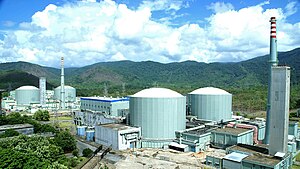Engineering:IPHWR-220
From HandWiki
Short description: Indian nuclear reactor design
| IPHWR-220 Reactor Class | |
|---|---|
 Kaiga Atomic Power Plant, showing four IPHWR-220 reactors | |
| Generation | Generation II reactor |
| Reactor concept | pressurized heavy-water reactor |
| Reactor line | IPHWR |
| Designed by | Bhabha Atomic Research Centre |
| Manufactured by | PPED, DAE (now part of NPCIL) |
| Status | 14 Operational |
| Main parameters of the reactor core | |
| Fuel (fissile material) | 235U (NU/SEU/LEU) |
| Fuel state | Solid |
| Neutron energy spectrum | Thermal |
| Primary control method | control rods |
| Primary moderator | Heavy water |
| Primary coolant | Heavy water |
| Reactor usage | |
| Primary use | Generation of electricity |
| Power (thermal) | 754.5 MWth |
| Power (electric) | 220 MWe |
The IPHWR-220 (Indian Pressurized Heavy Water Reactor-220) is an Indian pressurized heavy-water reactor designed by the Bhabha Atomic Research Centre.[1] It is a Generation II reactor developed from earlier CANDU based RAPS-1 and RAPS-2 reactors built at Rawatbhata, Rajasthan. It can generate 220 MW of electricity. Currently, there are 14 units operational at various locations in India. It is sometimes referred to as an small modular reactor due to its modularization.[2]
The IPHWR design was later expanded into 540 MW and 700 MW designs, as well as the AHWR-300 design.
Reactor fleet
| Power station | Location | Operation start | Status |
|---|---|---|---|
| MAPS-1 | Kalpakkam, Tamil Nadu | 27 January 1984 | Operational |
| MAPS-2 | 21 March 1986 | ||
| NAPS-1 | Narora, Uttar Pradesh | 1 January 1991 | |
| NAPS-2 | 1 July 1992 | ||
| KAPS-1 | Kakrapar, Gujarat | 6 May 1993 | |
| KAPS-2 | 1 September 1995 | ||
| RAPS-3 | Rawatbhata, Rajasthan | 1 June 2000 | |
| RAPS-4 | 23 December 2000 | ||
| RAPS-5 | 4 February 2010 | ||
| RAPS-6 | 31 March 2010 | ||
| KGS-1 | Kaiga, Karnataka | 6 November 2000 | |
| KGS-2 | 6 May 2000 | ||
| KGS-3 | 6 May 2007 | ||
| KGS-4 | 27 November 2010 |
Technical specifications
| Specifications | IPHWR-220[3] | IPHWR-540[4][5][6][7] | IPHWR-700[8] |
|---|---|---|---|
| Thermal output, MWth | 754.5 | 1730 | 2166 |
| Active power, MWe | 220 | 540 | 700 |
| Efficiency, net % | 27.8 | 28.08 | 29.08 |
| Coolant temperature, °C: | ? | ||
| core coolant inlet | 249 | 266 | |
| core coolant outlet | 293.4 | 310 | |
| Primary coolant material | Heavy Water | ||
| Secondary coolant material | Light Water | ||
| Moderator material | Heavy Water | ||
| Reactor operating pressure, kg/cm2 (g) | 87 | 100 | |
| Active core height, cm | 508.5 | 594 | 594 |
| Equivalent core diameter, cm | 451 | - | 638.4 |
| Average fuel power density | 9.24 KW/KgU | 235 MW/m3 | |
| Average core power density, MW/m3 | 10.13 | 12.1 | |
| Fuel | Sintered Natural UO2 pellets | ||
| Cladding tube material | Zircaloy-2 | Zircaloy-4 | |
| Fuel assemblies | 3672 | 5096 | 4704 fuel bundles in 392 channels |
| Number of fuel rods in assembly | 19 elements in 3 rings | 37 | 37 elements in 4 rings |
| Enrichment of reload fuel | 0.7% U-235 | ||
| Fuel cycle length, Months | 24 | 12 | |
| Average fuel burnup, MW · day / ton | 6700 | 7500 | 7050 |
| Control rods | SS/Co | Cadmium/SS | |
| Neutron absorber | Boric Anhydride | Boron | |
| Residual heat removal system | Active: Shutdown cooling system
Passive: Natural circulation through steam generators |
Active: Shutdown cooling system
Passive: Natural circulation through steam generators and Passive Decay heat removal system | |
| Safety injection system | Emergency core cooling system | ||
See also
- India's three-stage nuclear power programme
- Nuclear power in India
References
- ↑ "ANU SHAKTI: Atomic Energy In India". BARC. http://www.barc.gov.in/about/anushakti_phwr.html.
- ↑ "ARIS - Technical Data". IAEA. https://aris.iaea.org/sites/RPV.html.
- ↑ "Status report 74 - Indian 220 MWe PHWR (IPHWR-220)". International Automic Energy Agency. 2011-04-04. https://aris.iaea.org/PDF/IPHWR-220.pdf.
- ↑ Soni, Rakesh; Prasad, PN. "Fuel technology evolution for Indian PHWRs". International Atomic Energy Agency. https://inis.iaea.org/collection/NCLCollectionStore/_Public/37/098/37098316.pdf.
- ↑ Muktibodh, U.C (2011). "Design, Safety and Operability performances of 220 MWe, 540 MWe and 700 MWe PHWRs in India". Inter-Regional Workshop on Advanced Nuclear Reactor Technology for Near-term Deployment.
- ↑ Bajaj, S.S; Gore, A.R (2006). "The Indian PHWR". Nuclear Engineering and Design 236 (7–8): 701–722. doi:10.1016/j.nucengdes.2005.09.028.
- ↑ Singh, Baitej (July 2006). "Physics design and Safety assessment of 540 MWe PHWR". BARC Newsletter 270. http://barc.gov.in/publications/nl/2006/200607-2.pdf. Retrieved 2021-03-21.
- ↑ "Status report 105 - Indian 700 MWe PHWR (IPHWR-700)". International Atomic Energy Agency. 2011-08-01. https://aris.iaea.org/PDF/IPHWR-700.pdf.
 |

